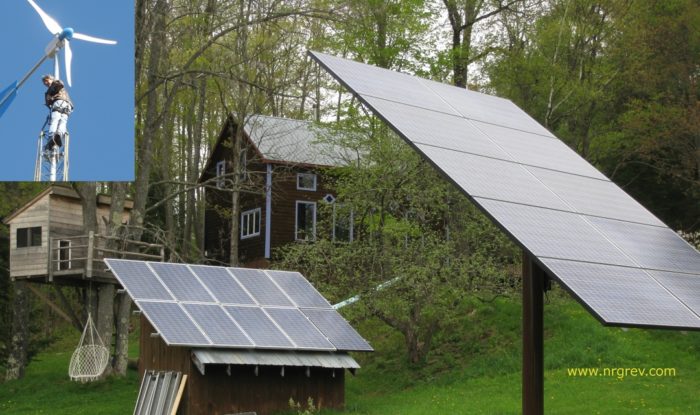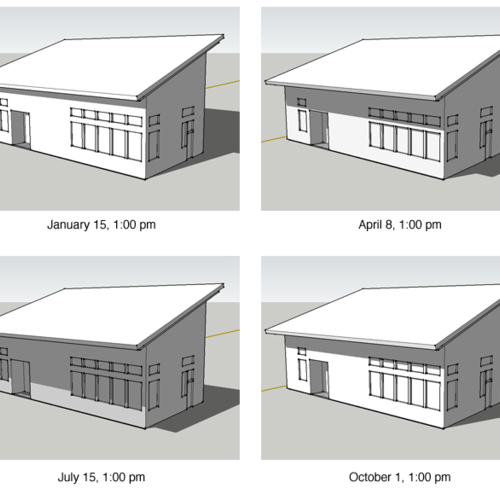
Off-grid in Vermont:
A 4-kW photovoltaic system and a 1-kW wind generator make plenty of power for Paul Scheckel's Vermont homestead.Image Credit: Paul Scheckel
Paul Scheckel’s career as an energy efficiency specialist began in 1988 when he spent $350 on a 50-watt solar electric panel and turned the bedroom of his rental house into an off-grid zone. A year later he began working for the company he’d purchased the solar panel from, and two years after that started an electric-car company with two friends.
By 1993, with the Vermont Electric Car Company now in the rearview mirror, Scheckel was working as an energy auditor. He bought a piece of land at the “end of a VT town road” and began building a house. Because the property was so far away from utility power, his only option was to make his house off-grid. He lived in a tent while he built the house.
In the intervening 20 years or so, Scheckel’s property has become a homestead powered largely by renewable energy. The 50-watt panel he once used for lighting and to run a coffee grinder has blossomed into a 2-kW photovoltaic array, augmented by a 1-kW wind generator. A diesel-powered generator keeps the family going when wind and solar aren’t enough.
Scheckel is the author of The Home Energy Diet (2005, New Society Publishers), writes a column for the local paper, The Times Argus/Rutland Herald, and has appeared on Ask This Old House. In his consulting work, he focuses on ultra-low energy designs and retrofits.
His blog, Energy Insights by Paul Scheckel, borrows heavily from his newspaper columns to explore a variety of topics. You can also visit his website .
Scheckel is an occasional blogger. There have been only three posts this year, but you’ll find some interesting content that probably isn’t covered elsewhere, such as details about Cuba’s renewable-energy effort (Cuba? Who knew?), and why you get sleepy after a big meal at Grandma’s house.
Here are some excerpts:
Cuba’s energy programs
“Out of economic and practical necessity, Cuba reduced its energy consumption by half over a period of four years. They have now become global leaders in practical, innovative approaches to energy efficiency, renewable energy, and community energy solutions — on a very tight budget. Cuba also looked to increase international cooperation. They now export technical expertise in health care, and have their own solar electric panel assembly facility.
“I was impressed by the small hydroelectric power station that used 30-year old Russian technology to provide power for 57 households. The same size system might provide enough power for four average American homes. Each family takes pride in some level of ‘ownership’ of the station and understands the limitations of a finite resource. If one family is being an energy hog, the whole neighborhood feels it. The local school takes power-priority and has a solar power system as a backup.”
No simple fix for over-consumption
“A few weeks ago I was interviewed on the ‘Green, Better, Best’ radio show. I was asked in advance to provide a ‘top ten’ list of energy saving tips for the home. I’ve been asked this many times before, and I always feel like I’m being asked to discover the ‘easy’ button. When it comes to energy generation and efficiency, there are no silver bullets that will take down the beast, but with good planning we can achieve success using ‘silver buckshot.’ ”
On the value of energy efficiency
“Efficiency is always faster, cheaper, and easier than building a new power plant. Unlike generation – be it coal, nuclear, wind, or anything else – it’s really hard to find any negative impacts of efficiency improvements to argue about.”
The problem with big holiday meals
“During our family thanksgiving gathering, I got out my CO2 meter to test the air while dinner cooked in the gas oven. The CO2 level in the house soon shot up to over .15%, so we turned on the exhaust fan. It helped a little, but not much. The CO2 level was closing in on .2% and yawns were exchanged by all. Two windows were opened to allow cross ventilation, and within minutes the CO2 levels dropped. I realize now that all those holiday meals at Grandma’s house were accompanied by an unknown poison that put us all to sleep. All we could really do in that environment was watch TV because we were all lethargic from poor indoor air quality.”
On making tough energy choices
“My friend’s annual CO2 footprint is 13.4 tons for the family’s direct energy purchases. Their indirect footprint includes commercial and industrial aspects of their lives such as the products they purchase and the food they eat, all of which require energy to produce and transport. Average total CO2 footprint for an American family is about 20 tons. Some climate scientists indicate that to maintain a non-threatening level of atmospheric CO2, each of the nearly 7 billion inhabitants of earth would have a budget of about 4 tons of CO2. If you had a limited carbon budget, how would you spend it?”
On the irony of bio-fuels
“Aside from the natural gas-derived nitrogen required to fertilize the plants that are the feedstock for biofuels, it takes lots of power to run a biofuel processing plant. Where are these processing plants? In the Midwest – where the corn and soybeans are. What’s the cheapest, most abundant energy source in the Midwest? Coal. I’m all for biofuels, but we need to use them efficiently so that we aren’t simply trading peak oil for peak soil.”
Weekly Newsletter
Get building science and energy efficiency advice, plus special offers, in your inbox.















0 Comments
Log in or create an account to post a comment.
Sign up Log in